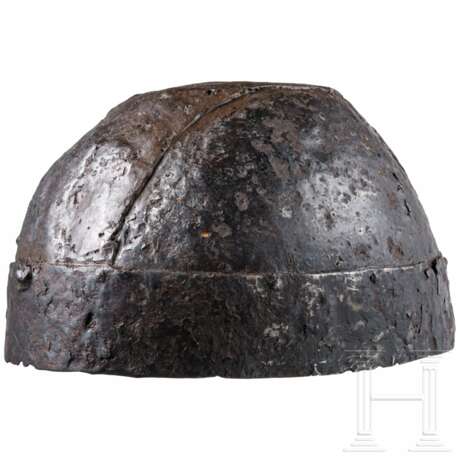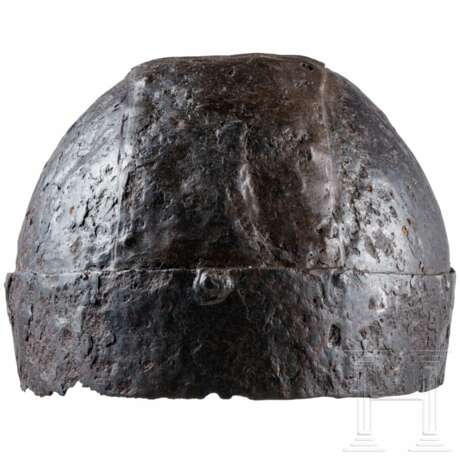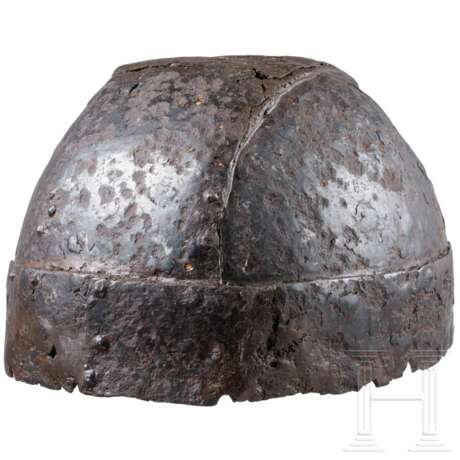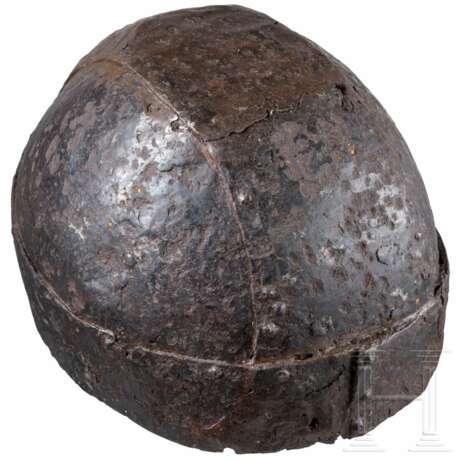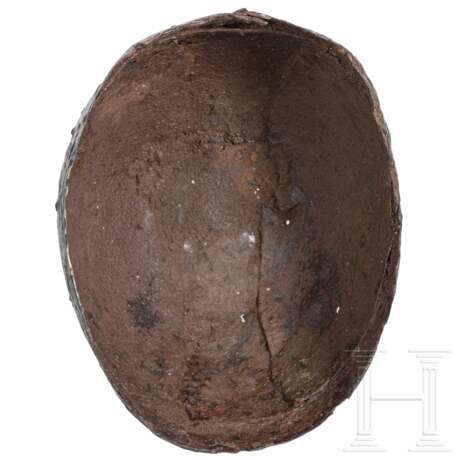ID 1417925
Лот 5365 | Bandhelm vom Typ St. Vid/Narona, spätes 5. - 6. Jhdt.
Eiserner Helm mit Kalotte aus vier verschweißten Teilstücken. Zwei seitliche "Kugelsegmente" von unten her an ein mittleres, an beiden Seiten leicht eingezogenes Band geschweißt, das sich von der Stirn zum Nacken zieht. An den Kanten des Mittelbandes befinden sich gegenüberliegende Dreiergruppen von Pseudonieten. Keiner der außen sichtbaren Nietköpfe gehört zu einem Niet, der beide Bleche durchstößt. Die "Nietköpfe" haben daher primär dekorativen Zweck, leiten sich aber von anderen spätantiken Helmen mit echter Nietverbindung als "typologisches Rudiment" ab. Um die so aus drei Teilen gefügte Kalotte herum am Rand ein 5 cm hohes Eisenband gelegt, das in den oberen ca. 1 - 2 cm mit der dreiteiligen Kalotte verschweißt ist und diese ca. 3 - 4 cm nach unten überragt. Das Eisenband überlappt sich ca. 5 mm im Nackenbereich, wo es ebenfalls verschweißt ist. Drei Nieten auf der Außenseite des Bandes nahe der Kante der Überlappung sind wieder nur Pseudonieten. Nur die "Nietköpfe" sind auf der Außenseite sichtbar und wohl von innen her durchgedrückt. Dies gilt gleichermaßen für "Nietköpfe" entlang der oberen Kante des Eisenbands, die eine nicht vorhandene Vernietung der Kalottensegmente mit dem Eisenband suggerieren. Dieses technische Merkmal der Pseudonieten ist auch als typisch für die bisher bekannten Helme dieses Typs beschrieben. Länge des Helms 23,5 cm. Breite 18 cm. Höhe 14 cm. Oberfläche mit leichten Korrosionsnarben. Insgesamt ausgezeichnet erhalten mit gut wahrnehmbaren technischen Details.
Es handelt sich um einen spätantiken Helmtyp, der sicher im spätrömischen Reich produziert wurde und dessen vereinzeltes Vorkommen in außerrömischen Kontexten als mediterraner Export anzusehen ist. Die genaue Zeitstellung dieser Helme zwischen spätem 5. und 6. Jahrhundert bedarf noch weiterer Forschungen. Es ist davon auszugehen, dass dieser Helmtyp chronologische Überlappungen mit anderen spätantiken Helmtypen hat und zumindest teilweise gleichzeitig mit diesen Helmtypen existierte (z.B. Berkasovo, Biberwier, Der-el-Medineh; frühbyzantinische Spangenhelme).
Provenienz: Süddeutsche Privatsammlung. Aus englischer Sammlung, von dort 2016 in die Artemis Gallery USA. Dort erworben vom jetzigen Besitzer.
A band helmet of the St Vid/Narona type, late 5th - 6th century A.D.
A band helmet of the St Vid/Narona type, late 5th - 6th century A.D.
Iron helmet with a calotte made of four welded sections. Two lateral "spherical segments" welded from below to a central band that is clearly indented on both sides and extends from the forehead to the nape. There are opposing groups of three pseudo-rivets on the edges of the centre band. None of the externally visible rivet heads belong to a rivet that pierces both sheets. The ‘rivet heads’ therefore have a primarily decorative purpose, but are derived from other late antique helmets with a genuine rivet connection as a "typological rudiment". A 5 cm high iron band was placed around the edge of the three-part calotte, which is welded to the three-part calotte in the upper approx. 1 - 2 cm and protrudes approx. 3 - 4 cm downwards. The iron band overlaps approx. 5 mm in the neck area, where it is also welded. Three rivets on the outside of the strap near the edge of the overlap are again only pseudo-rivets. Only the "rivet heads" are visible on the outside and are probably pressed through from the inside. This also applies to the 'rivet heads' along the upper edge of the iron band, which suggest that the spherical segments are riveted to the iron band. This technical feature of the pseudo-rivets is also described as typical of the helmets of this type known to date. Length of the helmet 23.5 cm. Width 18 cm. Height 14 cm. Surface with slight corrosion pitting. In overall excellent condition with clearly visible technical details.
It is a type of late antique helmet that was certainly produced in the late Roman Empire and whose isolated occurrence in non-Roman contexts can be regarded as a Mediterranean export. The exact date of these helmets between the late 5th and 6th century still requires further research. It can be assumed that this helmet type has chronological overlaps with other late antique helmet types and existed at least in part at the same time as these helmet types (e.g. Berkasovo, Biberwier, Der-el-Medineh; early Byzantine clasp helmets).
Provenance: Form a southern German private collection. Before from an English collection coming from the Artemis Gallery USA in 2016, who acquired it from the former owner.
Condition: II - III
| Категория аукционного дома: | Защитное оружие |
|---|
| Категория аукционного дома: | Защитное оружие |
|---|
| Адрес торгов |
Hermann Historica Bretonischer Ring 3 85630 Grasbrunn / München Германия | ||||||||||||||
|---|---|---|---|---|---|---|---|---|---|---|---|---|---|---|---|
| Предосмотр | |||||||||||||||
| Телефон | +49 (0)89 5472 649 0 | ||||||||||||||
| Факс | +49 (0)89 5472 64999 | ||||||||||||||
| Комиссия | 25 % | ||||||||||||||
| Условия использования | Условия использования | ||||||||||||||
| Часы работы | Часы работы
|
